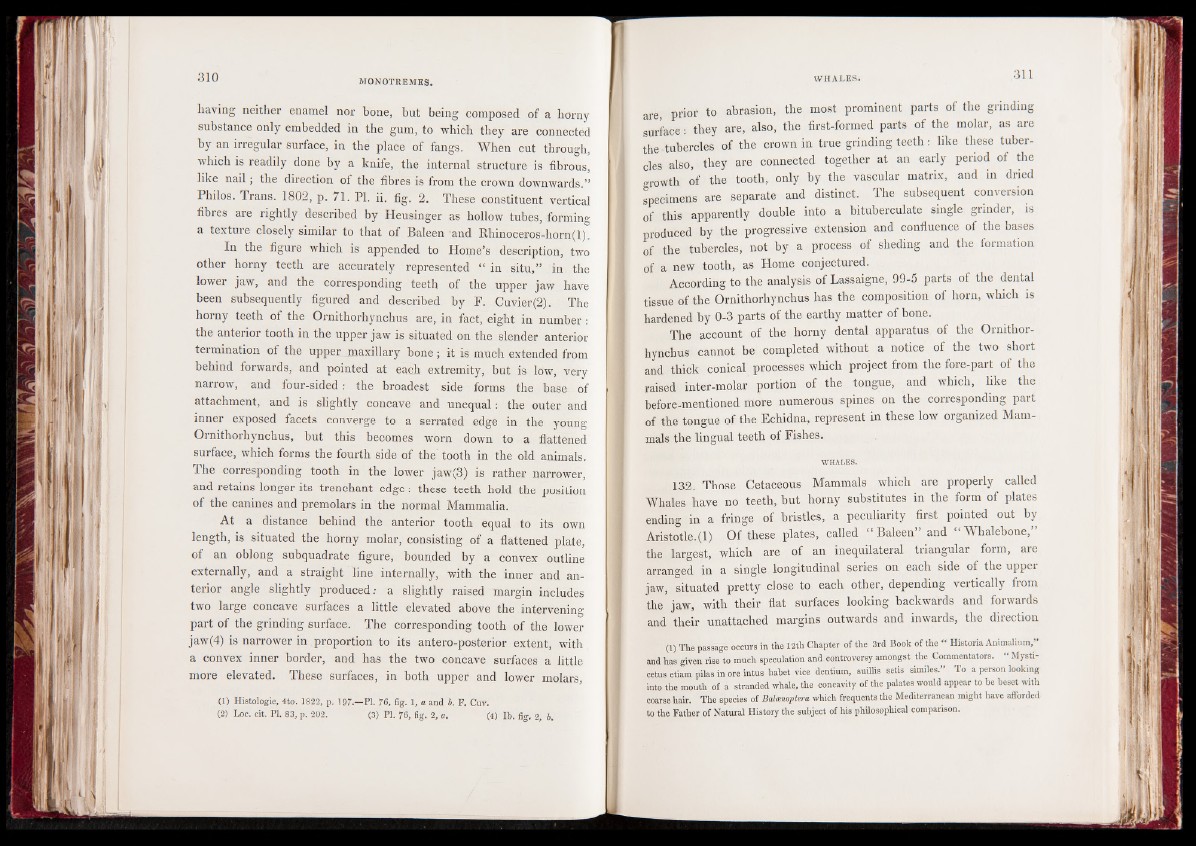
having neither enamel nor hone, but being composed of a horny
substance only embedded in the gum, to which they are connected
by an irregular surface, in the place of fangs. When cut through,
which is readily done by a knife, the internal structure is fibrous,
like nail; the direction of the fibres is from the crown downwards.”
Philos. Trans. 1802, p. 71. PI. ii. fig. 2. These constituent vertical
fibres are rightly described by Heusinger as hollow tubes, forming
a texture closely similar to that of Baleen 'and Rhinoceros-horn(l).
In the figure which is appended to Home’s description, two
other horny teeth are accurately represented “ in situ,” in the
lower jaw, and the corresponding teeth of the upper jaw have
been subsequently figured and described by F. Cuvier(2). The
horny teeth of the Ornithorhynchus are, in fact, eight in number I
the anterior tooth in the upper jaw is situated on the slender anterior
termination of the upper maxillary bone; it is much extended from
behind forwards, and pointed at each extremity, but is low, very
narrow, and four-sided: the broadest side forms the base of
attachment, and is slightly concave and unequal: the outer and
inner exposed facets converge to a serrated edge in the young
Ornithorhynchus, but this becomes worn down to a flattened
surface, which forms the fourth side of the tooth in the old animals.
The corresponding tooth in the lower jaw(3) is rather narrower,
and retains longer its trenchant edge: these teeth hold the position
of the canines and premolars in the normal Mammalia.
At a distance behind the anterior tooth equal to its own
length, is situated the horny molar, consisting of a flattened plate,
of an oblong subquadrate figure, bounded by a convex outline
externally, and a straight line internally, with the inner and anterior
angle slightly produced: a slightly raised margin includes
two large concave surfaces a little elevated above the intervening
part of the grinding surface. The corresponding tooth of the lower
jaw(4) is narrower in proportion to its antero-posterior extent, with
a convex inner border, and has the two concave surfaces a little
more elevated. These surfaces, in both upper and lower molars,
(X) Histologie, 4to. 1822, p. 197.—PI. 76, fig. 1, a and b. F. Cuv.
(2) Loc. cit. PI. 83, p. 202. (3) Pi. 76, fig. 2, a. (4) lb. fig. 2, b.
are, prior to abrasion, the most prominent parts of the grinding
surface I they are, also, the first-formed parts of the molar, as are
the tubercles of the crown in true grinding teeth: like these tubercles
also, they are connected together at an early period of the
growth of the tooth, only by the vascular matrix, and in dried
specimens are separate and distinct. The subsequent conversion
of this apparently double into a bituberculate single grinder, is
produced by the progressive extension and confluence of the bases
of the tubercles, not by a process of sheding and the formation
of a new tooth, as Home conjectured.
According to the analysis of Lassaigne, 99-5 parts of the dental
tissue of the Ornithorhynchus has the composition of horn, which is
hardened by 0-3 parts of the earthy matter of bone.
The account of the horny dental apparatus of the Ornithorhynchus
cannot be completed without a notice of the two short
and thick conical processes which project from the fore-part of the
raised inter-molar portion of the tongue, and which, like the
before-mentioned more numerous spines on the corresponding part
of the tongue of the Echidna, represent in these low organized Mammals
the lingual teeth of Fishes.
WHALES.
132. Those Cetaceous Mammals which are properly called
Whales have no teeth, but horny substitutes in the form of plates
ending in a fringe of bristles, a peculiarity first pointed out by
Aristotle.(1) Of these plates, called “ Baleen” and “ Whalebone,”
the largest, which are of an inequilateral triangular form, are
arranged in a single longitudinal series on each side of the upper
jaw, situated pretty close to each other, depending vertically from
the jaw, with their flat surfaces looking backwards and forwards
and their unattached margins outwards and inwards, the direction
(1) The passage occurs in the 12th Chapter of the 3rd Book of the “ Historia Animalium,”
and has given rise to much speculation and controversy amongst the Commentators. “ Mysti-
cetus etiam pilas in ore intus habet vice dentium, suillis setis similes.” To a person looking
into the mouth of a stranded whale, the concavity of the palates would appear to be beset with
coarse hair. The species of Balmnoptera which frequents the Mediterranean might have afforded
to the Father of Natural History the subject of his philosophical comparison.